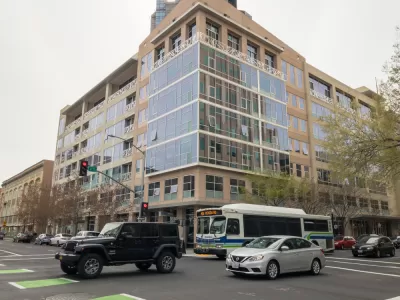One of the nation's most ambitious and sweeping statewide laws intended to spur affordable housing development was signed into law in California at the end of September.

California Governor Gavin Newsom last week signed two bills, AB 2011 and SB 6, which will allow by-right development of affordable housing developments on most commercially zoned properties in the state, allowing projects to circumvent the discretionary review processes of local governments and the review processes of the California Environmental Quality Act (CEQA).
The California State Legislature approved the dramatic statewide zoning reform in August, but the final step for approval was far from a sure thing—Gov. Newsom has a track record of vetoing bills favored by urbanists, including an Idaho Stop bill from last year’s legislative session.
“Both bills guarantee union-scale wages and promise an expedited construction process, while keeping development close to city centers to help the state meet its environmental goals and avoid sprawl,” reports Hannah Wiley for the Los Angeles Times. The support of labor unions—split after California Conference of Carpenters and the Service Employees International Union of California decided to support the bill—was essential to breaking the traditional political gridlock and winning approval for AB 2011, according to the article.
An August analysis by Joe Distefano and Peter Calthorpe for Urban Footprint found that the zoning reforms approved by the two bills could unlock enough land for development to yield 1.6 million to 2.4 million residential units.
FULL STORY: In groundbreaking plan, California allows affordable housing on some commercial properties

Alabama: Trump Terminates Settlements for Black Communities Harmed By Raw Sewage
Trump deemed the landmark civil rights agreement “illegal DEI and environmental justice policy.”

Planetizen Federal Action Tracker
A weekly monitor of how Trump’s orders and actions are impacting planners and planning in America.

The 120 Year Old Tiny Home Villages That Sheltered San Francisco’s Earthquake Refugees
More than a century ago, San Francisco mobilized to house thousands of residents displaced by the 1906 earthquake. Could their strategy offer a model for the present?

In Both Crashes and Crime, Public Transportation is Far Safer than Driving
Contrary to popular assumptions, public transportation has far lower crash and crime rates than automobile travel. For safer communities, improve and encourage transit travel.

Report: Zoning Reforms Should Complement Nashville’s Ambitious Transit Plan
Without reform, restrictive zoning codes will limit the impact of the city’s planned transit expansion and could exclude some of the residents who depend on transit the most.

Judge Orders Release of Frozen IRA, IIJA Funding
The decision is a victory for environmental groups who charged that freezing funds for critical infrastructure and disaster response programs caused “real and irreparable harm” to communities.
Urban Design for Planners 1: Software Tools
This six-course series explores essential urban design concepts using open source software and equips planners with the tools they need to participate fully in the urban design process.
Planning for Universal Design
Learn the tools for implementing Universal Design in planning regulations.
Clanton & Associates, Inc.
Jessamine County Fiscal Court
Institute for Housing and Urban Development Studies (IHS)
City of Grandview
Harvard GSD Executive Education
Toledo-Lucas County Plan Commissions
Salt Lake City
NYU Wagner Graduate School of Public Service





























